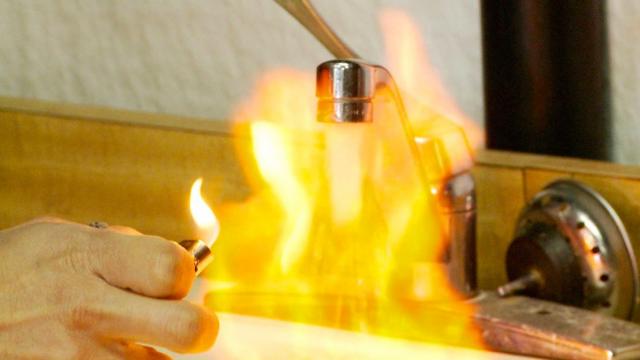
A Texas man is suing a group of fracking companies after burns from a methane explosion near his house allegedly hospitalized him for a week, burned his family, and caused permanent damage.
Cody Murray, 38, and his father, wife, and four-year-old daughter were all burned by a “fireball” after methane built up in his pump house and exploded when Murray entered the shed to check on a water issue. The lawsuit, filed last week against EOG Resources, Fairway Resources LLC, and three subsidiaries of Fairway, alleges the methane was from the defendants’ fracking wells just 1,000 feet from Murray’s house, which sits 35 miles outside Fort Worth.
“At the flip of the switch, Cody heard a ‘whooshing’ sound, which he instantly recognized from his work in the oil and gas industry, and instinctively picked his father up and physically threw him back and away from the entryway to the pump house,” the complaint states. “In that instant, a giant fireball erupted from the pump house, burning Cody and [his father], who were at the entrance to the pump house, as well as Ashley and A.M., who were approximately twenty feet away.”
Murray, who was closest to the blast, was burned on his arms, back, neck, and face and spent a week in intensive care after the accident last August. He is still unable to drive due to damage to his hands, the lawsuit states, and subsequently lost his job, which required several hours of driving each day. His father, wife, and daughter were also hospitalized, according to the lawsuit.
“It’s a very sad case. It’s terrible,” said trial lawyer Christopher Hamilton, who filed the suit in Dallas. Hamilton told ThinkProgress there are two issues that have historically prevented successful cases being brought against fracking companies. First, it’s difficult to determine that the methane (or other contamination) was directly caused by fracking.
Methane, a flammable greenhouse gas, is a major component of natural gas, but it also occurs naturally in the ground — a fact that has protected companies from lawsuits. Images of flammable tap water in Pennsylvania and Texas have raised alarm for years, but plaintiffs affected by the contamination were unsuccessful in establishing cause. New methods, though, have enabled scientists to track isotopes and determine where in the ground methane came from, Hamilton said, making it easier to establish causation.
“Rigorous scientific testing, including isotope testing, has conclusively demonstrated that the high-level methane contamination of the Murrays’ water well resulted from natural gas drilling and extraction activities. The high levels of methane in the Murrays’ well were not ‘naturally occurring,'” the complaint states.
The second issue in fracking cases is that it’s often difficult to directly connect physical damages to contamination, such as in the case of long-term exposure. For instance, another case in Texas that alleged fracking had caused nosebleeds and asthma was thrown out last summer. In Oklahoma, it took a state Supreme Court decision to uphold citizens’ rights to sue fracking companies over earthquakes.
In this case, though, there are “serious, catastrophic and likely permanent injuries that indisputably occurred due to methane,” Hamilton said.
The isotope-tracking science could open up a new avenue for litigation against fracking. Proponents of fracking claim that the extraction method — wherein thousands of gallons of chemical-laced water is pumped at high pressure into shale underground, loosening deposits of oil and gas — is perfectly safe. And in Texas, where Murray lives, fracking has experienced a huge, state-supported boom. Texas even passed legislation last year preventing towns and cities from banning fracking.
“This is a potentially landmark case,” Hamilton said. “I think this needs to set off an alarm for industry that they need to be casing these wells properly — in the way that scientists have been telling them for decades.”
In fact, methane leaks have been repeatedly linked to fracking operations. Satellite observations have shown that methane is leaking around fracking hotspots at such a high rate that there is no climate benefit in switching from coal to natural gas power, despite the fact that natural gas burns cleanly.
And methane leaks aren’t the only danger posed by fracking operations. Researchers from the University of Texas, Arlington tested water samples collected over the past three years from wells near fracking operations and found elevated levels of heavy metals such as arsenic. Their findings, released this summer, show elevated levels of 19 different chemicals including the so-called BTEX (benzene, toluene, ethyl benzene and xylenes) compounds. Heavy metals are toxic to humans, and BTEX compounds are considered carcinogenic.
A spokesperson for EOG Resources declined to comment on the case, citing company policy.
3 WAYS TO SHOW YOUR SUPPORT
- Log in to post comments














